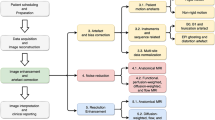Abstract
In total hip arthroplasty, analysis of postoperative medical images is important to evaluate surgical outcome. Since Computed Tomography (CT) is most prevalent modality in orthopedic surgery, we aimed at the analysis of CT image. In this work, we focus on the metal artifact in postoperative CT caused by the metallic implant, which reduces the accuracy of segmentation especially in the vicinity of the implant. Our goal was to develop an automated segmentation method of the bones and muscles in the postoperative CT images. We propose a method that combines Normalized Metal Artifact Reduction (NMAR), which is one of the state-of-the-art metal artifact reduction methods, and a Convolutional Neural Network-based segmentation using two U-net architectures. The first U-net refines the result of NMAR and the Bayesian muscle segmentation is performed by the second U-net. We conducted experiments using simulated images of 20 patients and real images of three patients to evaluate the segmentation accuracy of 19 muscles. In simulation study, the proposed method showed statistically significant improvement (p < 0.05) in the average symmetric surface distance (ASD) metric for 12 muscles out of 19 muscles and the average ASD of all muscles from 1.46 ± 0.904 mm (mean ± std. over all patients) to 1.30 ± 0.775 mm over our previous method. Addition to this, the high correlation ratio between segmentation accuracy and the estimated uncertainty was found. The real image study using the manual trace of gluteus maximus and medius muscles showed ASD of 1.89 ± 0.553 mm.








Similar content being viewed by others
References
Ronneberger, O., Fischer, P., & Brox, T. (2015). U-net: Convolutional networks for biomedical image segmentation. In International conference on medical image computing and computer-assisted intervention (pp. 234–241).
Lee, H., Troschel, F. M., Tajmir, S., Fuchs, G., Mario, J., Fintelmann, F. J., & Do, S. (2017). Pixel-level deep segmentation: artificial intelligence quantifies muscle on computed tomography for body morphometric analysis. Journal of Digital Imaging, 30(4), 487–498.
Dabiri, S., Popuri, K., Feliciano, E. M. C., Caan, B. J., Baracos, V. E., & Beg, M. F. (2019). Muscle segmentation in axial computed tomography (CT) images at the lumbar (L3) and thoracic (T4) levels for body composition analysis. Computerized Medical Imaging and Graphics, 75, 47–55.
Weston, A. D., Korfiatis, P., Kline, T. L., Philbrick, K. A., Kostandy, P., Sakinis, T., et al. (2018). Automated abdominal segmentation of CT scans for body composition analysis using deep learning. Radiology, 290(3), 669–679.
Hiasa, Y., Otake, Y., Takao, M., Ogawa, T., Sugano, N., & Sato, Y. (2019). Automated muscle segmentation from clinical CT using Bayesian U-net for personalized musculoskeletal Modeling. IEEE Transactions on Medical Imaging.
Meyer, E., Raupach, R., Lell, M., Schmidt, B., & Kachelrieß, M. (2010). Normalized metal artifact reduction (NMAR) in computed tomography. Medical Physics, 37(10), 5482–5493.
Gjesteby, L., Shan, H., Yang, Q., Xi, Y., Claus, B., Jin, Y., et al. (2018). Deep neural network for CT metal Artifact reduction with a perceptual loss function. In Proceedings of the fifth international conference on image formation in X-ray computed tomography (pp. 439–443).
Sakamoto, M., Hiasa, Y., Otake, Y., Takao, M., Suzuki, Y., Sugano, N., & Sato, Y. (2019). Automated segmentation of hip and thigh muscles in metal artifact contaminated CT using CNN. In International Forum on Medical Imaging in Asia 2019. International Society for Optics and Photonics, 11050, 110500.
Otake, Y., Sakamoto, M., Hiasa, Y., Takao, M., Suzuki Y., Sugano N., Sato, Y. (2019). Musculoskeletal modeling from a metal artifact contaminated CT for post-operative assessment of total hip arthroplasty. In International Workshop and Challenge on Computational Methods and Clinical Applications in Musculoskeletal Imaging (in press).
Meyer, E., Raupach, R., Lell, M., Schmidt, B., & Kachelrieß, M. (2012). Frequency split metal artifact reduction (FSMAR) in computed tomography. Medical Physics, 39(4), 1904–1916.
Zhang, Y., & Yu, H. (2018). Convolutional neural network based metal artifact reduction in X-ray computed tomography. IEEE Transactions on Medical Imaging, 37(6), 1370–1381.
Herman, G. T. (1979). Correction for beam hardening in computed tomography. Physics in Medicine & Biology, 24(1), 81.
Kyriakou, Y., Meyer, E., Prell, D., & Kachelrieß, M. (2010). Empirical beam hardening correction (EBHC) for CT. Medical Physics, 37(10), 5179–5187.
Berger, M., XCOM: photon cross sections database. http://www.nist.gov/pml/data/xcom/index.cfm. .
Simens Healthineers. Simulation of x-ray spectra. https://www.oem-xray-components.siemens.com/x-ray-spectra-simulation. .
Glorot, X., & Bengio, Y. (2010). Understanding the difficulty of training deep feedforward neural networks. In Proceedings of the thirteenth international conference on artificial intelligence and statistics (pp. 249-256).
Kingma, D. P., & Ba, J. (2014). Adam: A method for stochastic optimization. arXiv preprint arXiv:1412.6980.
Ogawa, T., Takao, M., Otake, Y., Yokota, F., Hamada, H., Sakai, T., Sato, Y., & Sugano, N. (2019). Validation study of the CT-based cross-sectional evaluation of muscular atrophy and fatty degeneration around the pelvis and the femur. Journal of Orthopaedic Science (in press).
Styner. M., Lee. J., Chin. B., Chin. M., Commowick. O., Tran. H. et al. (2008). 3D segmentation in the clinic: A grand challenge ii: Ms lesion segmentation. Midas Journal, 2008, 1–6.
Wu, D., Kim, K., Dong, B., & Li, Q. (2017). End-to-end abnormality detection in medical imaging. arXiv preprint arXiv:1711.02074. (version 1, https://arxiv.org/abs/1711.02074v1)
Shrivastava, A., Pfister, T., Tuzel, O., Susskind, J., Wang, W., & Webb, R. (2017). Learning from simulated and unsupervised images through adversarial training. In Proceedings of the IEEE Conference on Computer Vision and Pattern Recognition, 2107–2116.
Acknowledgements
This work was partly supported by KAKENHI 19H01176 and 26108004.
Author information
Authors and Affiliations
Corresponding author
Additional information
Publisher’s Note
Springer Nature remains neutral with regard to jurisdictional claims in published maps and institutional affiliations.
Appendix
Appendix
Rights and permissions
About this article
Cite this article
Sakamoto, M., Hiasa, Y., Otake, Y. et al. Bayesian Segmentation of Hip and Thigh Muscles in Metal Artifact-Contaminated CT Using Convolutional Neural Network-Enhanced Normalized Metal Artifact Reduction. J Sign Process Syst 92, 335–344 (2020). https://doi.org/10.1007/s11265-019-01507-z
Received:
Revised:
Accepted:
Published:
Issue Date:
DOI: https://doi.org/10.1007/s11265-019-01507-z




